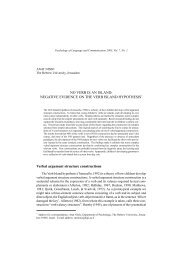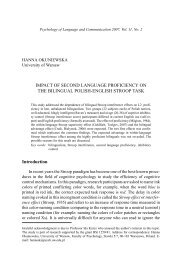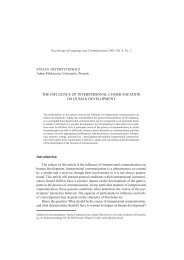Metaphors in preschool child thinking about the mind
Metaphors in preschool child thinking about the mind
Metaphors in preschool child thinking about the mind
You also want an ePaper? Increase the reach of your titles
YUMPU automatically turns print PDFs into web optimized ePapers that Google loves.
40 MARTA BIA£ECKA-PIKULTable 2. <strong>Metaphors</strong>’ testModality, Tenor Tender Question asked Type of metaphorbase of similarity by dollVision modality, color A girl dressed <strong>in</strong> green A frog Do you live <strong>in</strong> a lake? A conventional metaphor:as green as a frog(here a literal translation from Polish)Vision modality, color A girl dressed <strong>in</strong> yellow A lemon Are you sour? An orig<strong>in</strong>al metaphorVision modality (size ) A very tall man A giraffe Do you live <strong>in</strong> a zoo A conventional metaphor:as tall as a giraffe(here a literal translation from Polish)Vision modality (size ) A very tall woman A column Do you support <strong>the</strong> roof? An orig<strong>in</strong>al metaphorVision modality (shape) A boy with a rucksack A camel Do you live <strong>in</strong> a desert? A conventional metaphor:as load as a camel(here a literal translation from Polish)Vision modality (shape) An elephant A hoover Do you clean carpets? An orig<strong>in</strong>al metaphorK<strong>in</strong>aes<strong>the</strong>tic/motor A very fat man A roll<strong>in</strong>g barrel Are you roll<strong>in</strong>g? A conventional metaphor:movement modality runn<strong>in</strong>g to roll like a barrel,to be as fat as a barrel(here a literal translation from Polish)K<strong>in</strong>aes<strong>the</strong>tic/motor Merry-go-round A m<strong>in</strong>cer Are you m<strong>in</strong>c<strong>in</strong>g? An orig<strong>in</strong>al metaphormovement modality with <strong>child</strong>renTactile modality A hedgehog Syr<strong>in</strong>ges Do you give shots? a conventional metaphor:with needles as pricklly as a needle(here a literal translation from Polish)Tactile modality A woman <strong>in</strong> a fur coat A cat Do you like to be petted? An orig<strong>in</strong>al metaphor
METAPHORS IN PRESCHOOL CHILD THINKING ABOUT THE MIND41Figure 1. An example of pictures used to present a metaphor connected with color. The doll’squestion was: Do you live <strong>in</strong> a lake?The first false belief test was an unexpected transfer test described as <strong>the</strong> classic one<strong>in</strong> <strong>the</strong> <strong>in</strong>troduction. The second test was <strong>the</strong> deceptive box test (Perner, Leekman andWimmer, 1987) <strong>in</strong> which <strong>the</strong> <strong>child</strong> was presented with a candy box which turned out tobe full of pencils. At <strong>the</strong> beg<strong>in</strong>n<strong>in</strong>g, <strong>the</strong> <strong>child</strong> was asked to say what he or she thoughtwas <strong>in</strong> this box, <strong>the</strong>n <strong>the</strong> <strong>child</strong> saw <strong>the</strong> unexpected content. The ma<strong>in</strong> question was:What will a friend of yours th<strong>in</strong>k is <strong>in</strong> <strong>the</strong> box when he sees it for <strong>the</strong> first time, like this,closed? To answer correctly <strong>the</strong> <strong>child</strong> has to know that a friend will hold a false belief of<strong>the</strong> content of <strong>the</strong> box. The third false belief test was very similar to <strong>the</strong> unexpectedtransfer, but was presented <strong>in</strong> colored pictures. It was a story of a hippo who was misledby fea<strong>the</strong>rs flow<strong>in</strong>g beh<strong>in</strong>d <strong>the</strong> w<strong>in</strong>dow. The hippo had a false belief <strong>about</strong> <strong>the</strong> wea<strong>the</strong>rand went out to ski. The <strong>child</strong> looked at <strong>the</strong> pictures and listened to <strong>the</strong> story and <strong>the</strong>nhad to justify <strong>the</strong> hippo’s behavior and his surprise at see<strong>in</strong>g Teddy’s mum beat<strong>in</strong>g afea<strong>the</strong>r pillow at <strong>the</strong> w<strong>in</strong>dow under his apartment. The ma<strong>in</strong> question was: Why was thishippo so surprised when he saw Teddy’s mum beat<strong>in</strong>g a pillow? 2 A <strong>child</strong> could get 2po<strong>in</strong>ts for <strong>the</strong> correct answer <strong>in</strong> each test, so <strong>the</strong> maximum was 6 po<strong>in</strong>ts.<strong>Metaphors</strong> were presented <strong>in</strong> a color picture book ‘read’ toge<strong>the</strong>r with a <strong>child</strong> anda doll. The <strong>child</strong> was encouraged to solve some riddles with a friendly experimenter.Each of <strong>the</strong> ten metaphors was presented <strong>in</strong> two pictures - one present<strong>in</strong>g <strong>the</strong> tenor(<strong>the</strong> topic of a metaphor), <strong>the</strong> o<strong>the</strong>r <strong>the</strong> tender (<strong>the</strong> vehicle). For example, <strong>the</strong> dolllooked at <strong>the</strong> topic - a girl dressed <strong>in</strong> green, <strong>the</strong>n at <strong>the</strong> vehicle – a frog, and <strong>the</strong>n turnedback to <strong>the</strong> picture of <strong>the</strong> topic and asked “<strong>the</strong> strange question”. In this example,turn<strong>in</strong>g to <strong>the</strong> picture of <strong>the</strong> girl dressed <strong>in</strong> green <strong>the</strong> doll asked, “Do you live <strong>in</strong> alake?”. Then <strong>the</strong> experimenter asked <strong>the</strong> <strong>child</strong> <strong>the</strong> ma<strong>in</strong> test question, which was always<strong>the</strong> same <strong>in</strong> all metaphors: WHY COULD THIS DOLL ASK SOMETHINGLIKE THAT? WHY DID SHE ASK THIS? Table 2 shows all <strong>the</strong> metaphors, with <strong>the</strong>questions asked by <strong>the</strong> doll. Figure 1 presents <strong>the</strong> example described above.To answer <strong>the</strong> ma<strong>in</strong> test question <strong>the</strong> <strong>child</strong> has to perceive and understand <strong>the</strong>relation between <strong>the</strong> topic and <strong>the</strong> vehicle of <strong>the</strong> metaphor. Simultaneously, <strong>the</strong> <strong>child</strong>2The procedure was presented more precisely <strong>in</strong> ano<strong>the</strong>r article (Bia³ecka-Pikul, 1999).
42 MARTA BIA£ECKA-PIKULTable 3. The criteria of assessment of <strong>child</strong>ren’s answers <strong>in</strong> metaphor’s testNumber Description of answerof po<strong>in</strong>ts4 po<strong>in</strong>ts The <strong>child</strong> without any prompts uses conventional expressions justify<strong>in</strong>g<strong>the</strong> doll’s questions: e.g. “because <strong>the</strong> woman has a dress as green as afrog; “because <strong>the</strong> man is as tall as a giraffe”3 po<strong>in</strong>ts The <strong>child</strong> says “ because <strong>the</strong> woman has <strong>the</strong> same dress as <strong>the</strong> frog”,“because she is dressed <strong>in</strong> green”; so he or she perceived <strong>the</strong> metaphorical similarity between tenor and tender <strong>in</strong> accordance with <strong>the</strong> assumedfeatures. The <strong>child</strong> perceived significant common features of objects.2 po<strong>in</strong>ts The perceived similarity is not <strong>in</strong> accordance with <strong>the</strong> premises taken <strong>in</strong>toconsideration dur<strong>in</strong>g <strong>the</strong> construction of <strong>the</strong> method, but is seen <strong>in</strong> lessobvious, detailed features of objects (<strong>in</strong> <strong>the</strong> k<strong>in</strong>aes<strong>the</strong>tic metaphor <strong>the</strong> <strong>child</strong>says: because <strong>the</strong> man has brown shoes like a barrel)1 po<strong>in</strong>t The <strong>child</strong> states that <strong>the</strong> basis of <strong>the</strong> doll’s question is <strong>the</strong> set of pictures(e.g. “because <strong>the</strong>re is a barrel and <strong>the</strong>re is a man”). The justification isnot full and it is not a verbalization of a metaphor. The answer is <strong>about</strong> <strong>the</strong>reality of <strong>the</strong> picture (“<strong>the</strong>re is a frog and <strong>the</strong>re is a girl”) or <strong>the</strong> <strong>child</strong>’sknowledge (“because a lemon is sour”).O po<strong>in</strong>ts A <strong>child</strong> says noth<strong>in</strong>g <strong>in</strong>stead of reformulat<strong>in</strong>g and repeat<strong>in</strong>g <strong>the</strong> questionor says “I do not know” or “Because she wanted to ask this”has to take <strong>the</strong> perspective of ano<strong>the</strong>r person (a doll). He or she should attribute abelief to <strong>the</strong> doll, but this belief could be <strong>in</strong>vented only <strong>in</strong>directly, on <strong>the</strong> basis of <strong>the</strong>perceived similarity.It has to be po<strong>in</strong>ted out that because <strong>the</strong> material of metaphors allows a <strong>child</strong> tofreely <strong>in</strong>terpret <strong>the</strong> pictures and perceive <strong>the</strong> less important similarities, <strong>the</strong> presentedmetaphors didn’t have to be read exclusively <strong>in</strong> concordance with <strong>the</strong> assumptions.Any perceived similarity, justify<strong>in</strong>g a strange, silly question asked by <strong>the</strong> doll wasassessed as understand<strong>in</strong>g metaphors. The detailed criteria for assessment of <strong>the</strong> <strong>child</strong>ren’sanswers are presented <strong>in</strong> table 3.The criteria were objectively assessed by three, <strong>in</strong>dependent, competent judges.Each judge assessed at least 20 protocols. The categorization turned out to be reliableand <strong>the</strong> agreement <strong>in</strong> judges’ answers was high. W-Kendall’s <strong>in</strong>dex was 0.86 – 0.96for <strong>the</strong> <strong>in</strong>dividual items of <strong>the</strong> test and was significant.ResultsThe presented method exam<strong>in</strong>es <strong>child</strong>ren’s understand<strong>in</strong>g of metaphor as an aspectof <strong>child</strong>ren’s <strong>the</strong>ories of m<strong>in</strong>d, which was confirmed by <strong>the</strong> correlation betweenresults obta<strong>in</strong>ed with this method and <strong>the</strong> results obta<strong>in</strong>ed with three different classicfalse belief tests. It was significant and middle (of 0.51 to 0.67, p=0.01).
0000000000000000000000000000000000000000000000000000000000000000000000000000000000000000000000000000000000000000000000000000000000000000000000000000000000000000000000000000000000000000000000000000000000000000000000000000000000000000000000000000000000000000000000000000000000000000000000000000000000000000000000000000000000000000000000METAPHORS IN PRESCHOOL CHILD THINKING ABOUT THE MIND43Figure 2. Mean results accord<strong>in</strong>g to k<strong>in</strong>d of metaphor3,53000000000000000000000000000000000000000000000000000000000000000000000000000000000000000000000000000000000000002,500000000000000000000000000000000000000000000000000000000000000000000000000000000000000000000000000000000000000mean20000000000000000000000000000000000000000000000000000000000000000000000000000000000000000000000000000000000000000000000000000000000000000000000000000000000000000000000000000000000000000000000000000000000000000000000000000001,50000000000000000000000000000000000000000000000000000000000000000000000001000000000000000000000000000000000000000000000000000000000000000000000000000000000000000000000000000000000000000,500000000000000000000000000000000000000000000000000000000000000000000000000000000000000000000000000000000000000000000000000000000000000000000000000000000000000000000000000000000000000000000000000000000000000000000000000000colorshape0000000000000000000size000000000000000000motorsensetouchThe <strong>child</strong>ren were presented metaphors related to <strong>the</strong> basic senses, i.e. vision (herewe have metaphors connected with three dimensions - color, size and shape), touchand movement. There were 10 metaphors, two of <strong>the</strong>m always related to differentsenses (two- to color, two to size , two to shape, two tactile metaphors, and two relatedto movement; see Table 2). Dur<strong>in</strong>g <strong>the</strong> session <strong>the</strong> metaphors were mixed to avoid anyk<strong>in</strong>d of similarity between items. We hypo<strong>the</strong>sized that similarity <strong>in</strong> color would be<strong>the</strong> easiest for <strong>child</strong>ren. But it turned out that although <strong>the</strong> easiest were “color metaphors”,<strong>the</strong> only significant difference was between metaphors connected with sizeand all <strong>the</strong> o<strong>the</strong>r k<strong>in</strong>ds. This is shown <strong>in</strong> <strong>the</strong> Figure 2.It could be said that <strong>the</strong> ability to perceive similarity between objects as <strong>the</strong> basis of<strong>the</strong> doll’s beliefs was <strong>in</strong>dependent of <strong>the</strong> modality that should be taken <strong>in</strong>to account tosee <strong>the</strong> similarity. Difficulties with metaphors connected with size were probably causedby <strong>the</strong> fact that <strong>the</strong> feature “size” is not absolute. To express this feature we drew a managa<strong>in</strong>st a door <strong>in</strong> <strong>the</strong> background (His head is below <strong>the</strong> frame) or a woman close to a busstop sign (her head was at <strong>the</strong> same level as <strong>the</strong> sign). To perceive that <strong>the</strong>y are really tall,a <strong>child</strong> has to see <strong>the</strong> relation between <strong>the</strong> frame or <strong>the</strong> road sign and <strong>the</strong> height of <strong>the</strong>person. It was certa<strong>in</strong>ly more difficult than just to see <strong>the</strong> colour of <strong>the</strong> dress. This showshow difficult it is to draw pictures of metaphors connected with different senses. But it isreally worth do<strong>in</strong>g, especially because of <strong>the</strong> <strong>child</strong>ren’s answers. For example, 5-yearsoldAnn look<strong>in</strong>g at <strong>the</strong> picture of a giraffe and <strong>the</strong> tall man and comment<strong>in</strong>g on <strong>the</strong> doll’squestion (Do you live <strong>in</strong> a zoo?) said that <strong>the</strong> doll asked such a question: “Because shethought that <strong>the</strong> man was a giraffe” (and asked why she thought this) “Because he is tall
44 MARTA BIA£ECKA-PIKULFigure 3. Understand<strong>in</strong>g of conventional and orig<strong>in</strong>al metaphors - mean resultand handsome”. The boy – Michael, also 5- years-old – look<strong>in</strong>g at a picture of a columnand a tall woman and <strong>the</strong>n comment<strong>in</strong>g on <strong>the</strong> doll’s question (Do you support/prop upa roof?) said that <strong>the</strong> doll could ask someth<strong>in</strong>g like this, because “<strong>the</strong> woman is as tall asa column and she looks like a column and she is as th<strong>in</strong> as a rake”. The last part of thisanswer is especially <strong>in</strong>terest<strong>in</strong>g because, although <strong>the</strong> material did not suggest it, <strong>the</strong><strong>child</strong> used a conventional expression, a common set comb<strong>in</strong>ation of words that are frequentlyused <strong>in</strong> <strong>the</strong> Polish language (e.g. <strong>in</strong> Polish as thick as a barrel, <strong>the</strong> English equivalentbe<strong>in</strong>g ‘as fat as butter’).The metaphor test consists of five conventional metaphors which could be expressed<strong>in</strong> a common comb<strong>in</strong>ation of words (<strong>in</strong> Polish - as green as a frog) and fiveorig<strong>in</strong>al metaphors created for <strong>the</strong> purpose of <strong>the</strong> study, which had to be <strong>in</strong>terpretedand are not used as set phrases <strong>in</strong> <strong>the</strong> Polish language (i.e. an elephant’s trunk as <strong>the</strong>pipe of a vacuum-cleaner). We assumed that conventional metaphors would be easierto perceive because l<strong>in</strong>guistic knowledge <strong>in</strong>fluences <strong>the</strong> understand<strong>in</strong>g of <strong>the</strong> world.The hypo<strong>the</strong>sis was confirmed (see Figure 3). Conventional metaphors were easierfor <strong>child</strong>ren.To sum up, it could be said that prechool <strong>child</strong>ren are equally good at perceiv<strong>in</strong>gand understand<strong>in</strong>g metaphors that refer to different modalities. <strong>Metaphors</strong> explicitlyexpressed <strong>in</strong> language are easier and more available to <strong>the</strong>m.mean1,251,21,151,11,0510,950,93For this analysis we treated correct answer from table 3 as always worth 2 po<strong>in</strong>ts, a realistic answer as 1po<strong>in</strong>t and 0 for “I do not know” or no answer.
METAPHORS IN PRESCHOOL CHILD THINKING ABOUT THE MIND45To present changes <strong>in</strong> understand<strong>in</strong>g metaphors <strong>in</strong> relation to age we calculated<strong>the</strong> r-Pearson’s correlation <strong>in</strong>dex. Age was counted <strong>in</strong> months and metaphor understand<strong>in</strong>gwas calculated by <strong>the</strong> MET <strong>in</strong>dex (a range between 0 and 20 because <strong>the</strong>rewere 10 metaphors, each worth a maximum of 2 po<strong>in</strong>ts 3 ). The Pearson’s <strong>in</strong>dex was0.70 on p
46 MARTA BIA£ECKA-PIKUL<strong>the</strong> situation and, on <strong>the</strong> basis of <strong>the</strong> silly question, predict <strong>the</strong> belief of <strong>the</strong> doll and<strong>the</strong>n give <strong>the</strong> arguments of <strong>the</strong> question. This is a really hard task measur<strong>in</strong>g more <strong>the</strong>n<strong>the</strong> use of language. A <strong>child</strong> has to analyze <strong>the</strong> use of language of ano<strong>the</strong>r person, adoll. So it is a metapragmatic task. Analyz<strong>in</strong>g <strong>the</strong> obta<strong>in</strong>ed results <strong>in</strong> relation to <strong>the</strong>role of language <strong>in</strong> <strong>the</strong>ory of m<strong>in</strong>d acquisition we emphasize <strong>the</strong> importance ofmetapragmatic competence. The results reveal that <strong>the</strong>re is <strong>the</strong> difference <strong>in</strong> <strong>child</strong>ren’sunderstand<strong>in</strong>g of conventional and orig<strong>in</strong>al metaphors and that is an additional <strong>in</strong>sighton <strong>the</strong> presented claim. When a <strong>child</strong> uses language, he or she uses metaphors to talk<strong>about</strong> <strong>the</strong> world and he or she can more easily understand <strong>the</strong> thoughts of o<strong>the</strong>r people.Secondly, we comment on difficulties <strong>in</strong> construct<strong>in</strong>g ecologically valid methodsto exam<strong>in</strong>e <strong>child</strong>ren’s knowledge <strong>about</strong> <strong>the</strong> m<strong>in</strong>d. The presented data show that it isvery difficult to present metaphors <strong>in</strong> <strong>the</strong> form of a draw<strong>in</strong>g and to picture metaphorsconnected with all modalities. Although <strong>the</strong> results are encourag<strong>in</strong>g we need to workon a method to prepare tasks present<strong>in</strong>g o<strong>the</strong>r modalities, like taste or hear<strong>in</strong>g.Thirdly, it is worth mention that <strong>the</strong> metaphor test allowed us to analyze <strong>child</strong>ren’sanswers <strong>in</strong> many ways. Read<strong>in</strong>g <strong>the</strong> protocols leads to conclusions that <strong>the</strong>re are manyk<strong>in</strong>ds or types of <strong>child</strong>ren’s answers. It is especially <strong>in</strong>terest<strong>in</strong>g to check if short answers(like: “Because <strong>the</strong> girl has a green dress”) are less adequate, less precise than longer ones(“Because <strong>the</strong>re is a frog and a girl dressed <strong>in</strong> green like a frog”). Longer answers justified<strong>the</strong> doll’s questions <strong>in</strong> a more detailed way. From <strong>the</strong> l<strong>in</strong>guistic po<strong>in</strong>t of view <strong>the</strong> first,shorter answer is even better <strong>the</strong>n <strong>the</strong> second because it is an ellipsis. Maybe a <strong>child</strong> justuses <strong>the</strong> Quantity Maxim and makes <strong>the</strong> answer <strong>in</strong> a condensed form. Contrary to this,from <strong>the</strong> Karmiloff-Smith (1995) position, <strong>the</strong> second longer answer is a more explicitverbalization of <strong>the</strong> representation and is more mature. Check<strong>in</strong>g if older <strong>child</strong>ren use <strong>the</strong>second k<strong>in</strong>d of answer more frequently, we analyzed only protocols where <strong>child</strong>ren’s answersconsisted of more than half of <strong>the</strong> metaphors (we excluded protocols where <strong>child</strong>rengave answers with less than 5 metaphors). We assessed shorter, implicit answers as 1 po<strong>in</strong>tand longer, more explicit as 2 po<strong>in</strong>ts. The significant r-Pearson correlation <strong>in</strong>dex (0.61,p
METAPHORS IN PRESCHOOL CHILD THINKING ABOUT THE MIND47ReferencesBartsch, K., & Wellman, H. (1995). Children talk <strong>about</strong> <strong>the</strong> m<strong>in</strong>d. New York, Oxford:Oxford University Press.Bia³ecka-Pikul, M. (2001). Dzieciêce teorie umys³u. Jak dzieci rozumiej¹ zdziwienie?Psychologia Rozwojowa, 6, 1-2, 11-22.Bia³ecka-Pikul, M. (2002). Co dzieci wiedz¹ o umyœle i myœleniu. Badania i opisdzieciêcej reprezentacji stanów mentalnych. Kraków: Wydawnictwo UJ.De Villiers, J. G.,& de Villiers, P. (1999). L<strong>in</strong>guistic determ<strong>in</strong>ation and <strong>the</strong> understand<strong>in</strong>gof false beliefs. In: P. Mitchell & K.J. Riggs (eds.), Children’s reason<strong>in</strong>gand <strong>the</strong> m<strong>in</strong>d (p. 191-228). Hove, UK: Psychology Press.Deleau M. (2003). Language and representation of beliefs <strong>in</strong> <strong>child</strong>ren. Lecture presentedat <strong>the</strong> 12th National Conference on Developmental Psychology, Kraków,Poland.Flavell, J. H., Miller, P. H., & Miller, S. A. (1993). Cognitive Development. EnglewoodCliffs, NJ: Prentice Hall Inc.Gardner, H. (1974). Metaphoric modalities. How <strong>child</strong>ren project polar adjectives ontodiverse doma<strong>in</strong>s, Child Development, 45, 84-91.Jenk<strong>in</strong>s, J.M., & Ast<strong>in</strong>gton, J.W. (1996). Cognitive factors and family structures associatedwith Theory of M<strong>in</strong>d development <strong>in</strong> young <strong>child</strong>ren. Developmental Psychology,32, 70-78.Karmiloff-Smith, A. (1995). Beyond modularity. A developmental perspective on cognitivescience. Cambridge: MIT Press.Lakoff, G. & Johnson, M. (1988). Metafory w naszym ¿yciu. Warszawa: PIW (translationfrom orig<strong>in</strong>al version)Mitchell, P. (1997). Introduction to <strong>the</strong> Theory of M<strong>in</strong>d. New York: Arnold.Perner, J., Leekman, S., & Wimmer, H. (1987). Three-year-olds’ difficulty with falsebelief: The case of conceptual deficit. British Journal of Developmental Psychology,5, 125-137.Siegal, M. (1999). Language and thought: <strong>the</strong> fundamental significance of conversationalawareness for cognitive development. Developmental Science, 2, 1,1-34.Wellman, H., Cross, D., & Watson, J. (2001). Meta-Analysis of Theory-of-M<strong>in</strong>d Development:The Truth <strong>about</strong> False Belief. Child Development, 72,3, 655-684.Wimmer, H., & Perner, D. (1983). Beliefs <strong>about</strong> beliefs. Cognition, 13, 103-128.W<strong>in</strong>ner, E. (1979). New names for old th<strong>in</strong>gs: The emergence of metaphoric language.Journal of Child Language, 6, 469-491.W<strong>in</strong>ner, E., Rosenthal, A., & Gardner, H. (1976). The development of metaphoricunderstand<strong>in</strong>g. Developmental Psychology, 12, 289-297.








